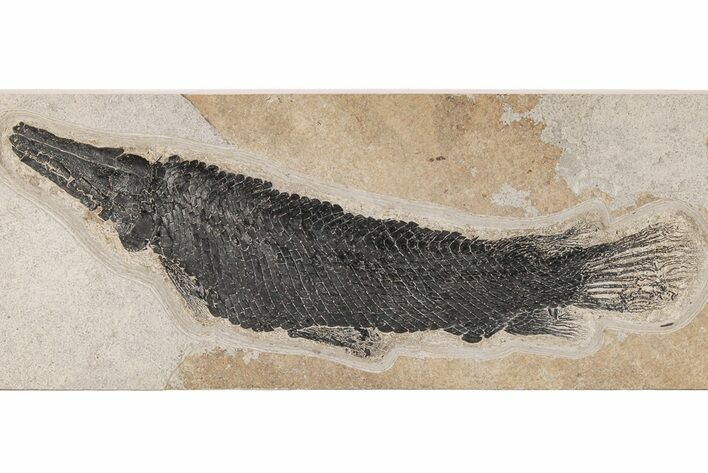This Specimen has been sold.
16.8" Fossil Gar (Lepisosteus) From Wyoming - Spectacular Scales!
Gars are one of the largest and rarest fish found in the Green River Formation. Lepisosteus was a fierce predator, having a long, narrow mouth full of teeth. They also had large, thick scales which are beautifully preserved in this specimen. This stunning specimen is on the small side at 18.3" in length, and is nicely centered on a 16.8 x 7.2" slab of shale which has been backed with wood for easy mounting. Upon request, we can attach wall mounting hardware to the wood.
This specimen was found via cross-section, so there is a repaired crack that runs diagonally through the fish that's about 7.5" from the caudal fin. Four of the scales have been restored along the ventral side of the fish at the spot of repair. The anal fin has been entirely restored, along with portions of the head (upper right side and lower left jaw). The restoration is best viewed under short-wave ultraviolet light.
This specimen was found via cross-section, so there is a repaired crack that runs diagonally through the fish that's about 7.5" from the caudal fin. Four of the scales have been restored along the ventral side of the fish at the spot of repair. The anal fin has been entirely restored, along with portions of the head (upper right side and lower left jaw). The restoration is best viewed under short-wave ultraviolet light.
About Fossil Lake
50 million years ago, in the Eocene epoch, these fish thrived in Fossil Lake, which was fed by the Uinta and Rocky Mountain highlands. The anoxic conditions at the bottom of Fossil Lake slowed bacterial decomposition, prevented scavengers from disturbing corpses, and, most interestingly, suffocated creatures that ventured into the oxygen-starved aquatic layer. The result is a miraculous exhibition of Eocene biota: a subtropical aquatic community within sycamore forests, teeming with creatures such as freshwater stingrays, dog-sized horses, menacing alligators, early flying bats, and one of the first primates.
50 million years ago, in the Eocene epoch, these fish thrived in Fossil Lake, which was fed by the Uinta and Rocky Mountain highlands. The anoxic conditions at the bottom of Fossil Lake slowed bacterial decomposition, prevented scavengers from disturbing corpses, and, most interestingly, suffocated creatures that ventured into the oxygen-starved aquatic layer. The result is a miraculous exhibition of Eocene biota: a subtropical aquatic community within sycamore forests, teeming with creatures such as freshwater stingrays, dog-sized horses, menacing alligators, early flying bats, and one of the first primates.
SPECIES
Lepisosteus sp.
LOCATION
Lindgren Quarry, Kemmerer, Wyoming
FORMATION
Green River Formation
SIZE
16.8" long (around curve) on 18.8 x 7.2" rock
CATEGORY
SUB CATEGORY
ITEM
#206437
We guarantee the authenticity of all of our specimens.
 Reviews
Reviews




















